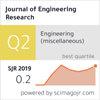Optimization of PMEDM process parameters for B4C and B4C+SiC reinforced AA7075 composites
IF 0.9
4区 工程技术
Q3 ENGINEERING, MULTIDISCIPLINARY
引用次数: 0
Abstract
Materials
With sufficient electrical conductivity can be successfully processed by applying the electrical discharge machining (EDM) method; however, due to the presence of non-conductive particles in composites, which have been produced by adding ceramics particles, problems such as unstable machining, low material removal rate, and high tool wear are observed during the EDM. This study employed powder-mixed electrical discharge machining (PMEDM) by adding electrically conductive nano-size graphite powder into the dielectric liquid to minimize these problems. Moreover, the machinability of AA7075/ B4C and AA7075/ B4C+SiC composites was evaluated using the Taguchi method. The experimental study used L18 orthogonal array (OA) (21 ×32). ANOVA was employed to obtain significant parameters and percent contributions of variable parameters on the material removal rate (MRR). Reinforcement ratio, current and sintering time applied to the workpiece were chosen as variable parameters. The optimum parameters for MRR were obtained at A1B3C3 (reinforcement ratio= 10%, current= 8 A, sintering time=150 min). According to S/N ratio graphs, increasing the reinforcement ratio leads to a decreased MRR. On the contrary, when the applied current increases, MRR increases. Additionally, analysis results show that the discharge current is the most important parameter affecting MRR. In the morphological examinations, it was understood that the amounts of B4C and SiC particles in the composite structure affect the quality of the machined surfaces. It was determined that the surface quality deteriorated with the increase in the amount of SiC and B4C in the composite structure and the increase in the discharge current.
B4C及B4C+SiC增强AA7075复合材料PMEDM工艺参数优化
具有足够导电性的材料可以通过应用电火花加工(EDM)方法成功加工;然而,由于添加陶瓷颗粒制备的复合材料中存在非导电颗粒,在电火花加工过程中存在加工不稳定、材料去除率低、刀具磨损大等问题。本研究采用粉末混合电火花加工(PMEDM),在介质液体中加入导电的纳米级石墨粉末,以最大限度地减少这些问题。采用田口法对AA7075/ B4C和AA7075/ B4C+SiC复合材料的可加工性进行了评价。实验研究采用L18正交阵列(OA) (21 ×32)。采用方差分析得到各参数对材料去除率(MRR)的显著性参数和贡献百分比。选取增强率、电流和工件烧结时间作为可变参数。在A1B3C3(增强率为10%,电流为8 A,烧结时间为150 min)下获得了最佳的MRR参数。从信噪比图中可以看出,增加配筋率会导致MRR降低。相反,当外加电流增大时,MRR增大。此外,分析结果表明,放电电流是影响MRR的最重要参数。形貌分析表明,复合材料组织中B4C和SiC颗粒的含量会影响加工表面的质量。结果表明,随着复合材料中SiC和B4C含量的增加和放电电流的增大,复合材料的表面质量逐渐恶化。
本文章由计算机程序翻译,如有差异,请以英文原文为准。
求助全文
约1分钟内获得全文
求助全文
来源期刊

Journal of Engineering Research
ENGINEERING, MULTIDISCIPLINARY-
CiteScore
1.60
自引率
10.00%
发文量
181
审稿时长
20 weeks
期刊介绍:
Journal of Engineering Research (JER) is a international, peer reviewed journal which publishes full length original research papers, reviews, case studies related to all areas of Engineering such as: Civil, Mechanical, Industrial, Electrical, Computer, Chemical, Petroleum, Aerospace, Architectural, Biomedical, Coastal, Environmental, Marine & Ocean, Metallurgical & Materials, software, Surveying, Systems and Manufacturing Engineering. In particular, JER focuses on innovative approaches and methods that contribute to solving the environmental and manufacturing problems, which exist primarily in the Arabian Gulf region and the Middle East countries. Kuwait University used to publish the Journal "Kuwait Journal of Science and Engineering" (ISSN: 1024-8684), which included Science and Engineering articles since 1974. In 2011 the decision was taken to split KJSE into two independent Journals - "Journal of Engineering Research "(JER) and "Kuwait Journal of Science" (KJS).
 求助内容:
求助内容: 应助结果提醒方式:
应助结果提醒方式:


